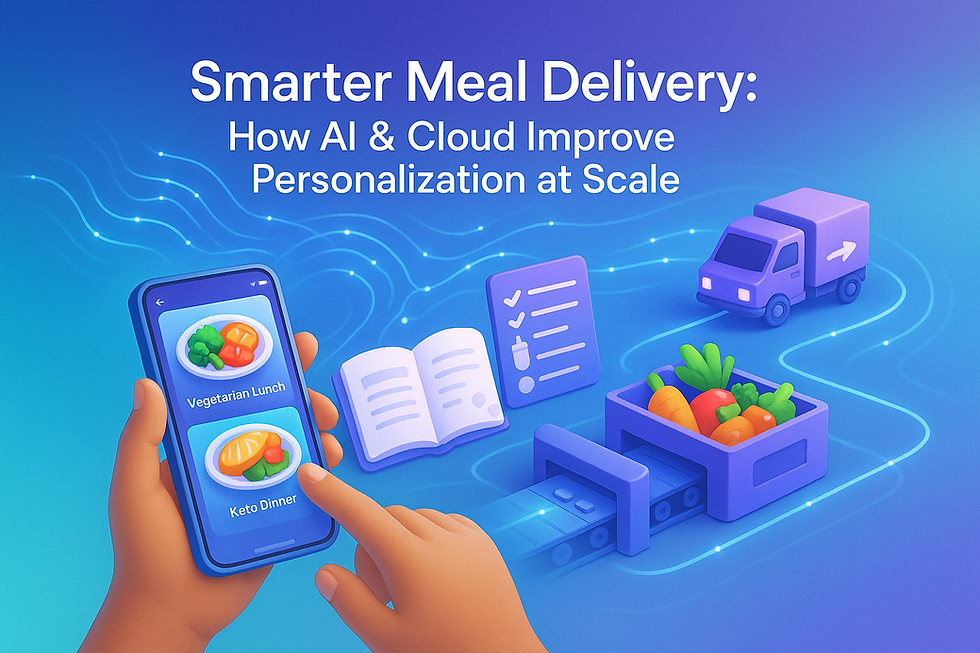Smarter Meal Delivery: How AI & Cloud Improve Personalization at Scale
- robot47
- Jul 22
- 4 min read
Updated: Aug 26

Mealtime Is Changing—and So Are Expectations
In the fast-paced modern world, food is no longer just about nutrition. For many, it’s a daily intersection of convenience, health goals, family schedules, and personal preference.
Whether it’s a vegetarian meal for Tuesday lunch or a keto dinner on Friday, people want food that fits their lifestyle—without the hassle of planning, prepping, or second-guessing. That’s where personalized meal delivery services enter the scene.
But delivering personalization at scale isn't easy. Behind the scenes, these services must coordinate recipe planning, ingredient sourcing, inventory management, packaging, logistics, and customer experience—all in real time.
So, how do the best meal delivery platforms make it work?
The answer lies in the combined power of cloud infrastructure and AI agents—systems that don’t just collect data, but act on it to improve every part of the supply chain.
🧩 The Data-to-Dinner Pipeline: How AI and Cloud Systems Transform Delivery
When you subscribe to a meal kit service, it might seem like magic: your preferences are remembered, your weekly menu feels "just right," and your meals arrive fresh and portioned.
But behind that magic is a deeply integrated network of systems working together to achieve four key outcomes:
Personalized Customer Experience
Accurate Ingredient Forecasting
Efficient Fulfillment Logistics
Continuous Optimization from Feedback
These outcomes are made possible by cloud-first systems and intelligent agents that go beyond analytics—they decide and act.
Let’s explore how.
☁️ Why Cloud Infrastructure Is the Unsung Hero
Modern meal delivery businesses operate across multiple regions, kitchens, and fulfillment hubs. They need systems that can adapt, scale, and deliver insights without delay.
Here’s how cloud architecture makes that possible:
1. Centralized, Real-Time Data Lakes
Instead of scattered Excel sheets or siloed software, everything flows into a unified cloud repository:
Customer behavior data (preferences, past orders, skipped meals)
Ingredient sourcing and pricing
Delivery times and satisfaction feedback
Seasonal availability and market trends
This centralization enables the business to see the full picture, not just pieces.
2. Elastic Infrastructure
A spike in orders during holidays? No problem. Need to test a new menu in just one city? Done.
Cloud systems scale up or down depending on demand—saving cost and avoiding over-investment in fixed infrastructure.
🤖 The Role of AI Agents: Not Just Smart, but Proactive
AI agents sit on top of cloud data systems and act as decision-makers and coordinators. They're not static algorithms. They're dynamic, evolving systems designed to optimize outcomes and reduce human load.
Here’s what they’re enabling in meal delivery:
🍽 Personalized Meal Planning at Scale
By analyzing a customer’s ordering history, dietary restrictions, ingredient ratings, and even behavior patterns (like skipping deliveries), AI agents can:
Suggest meals more likely to be accepted
Balance health, novelty, and budget preferences
Auto-generate menus weeks in advance
This means each customer sees a tailored experience, not just a mass offering.
📦 Inventory Forecasting That Minimizes Waste
Wasted ingredients are costly—for the business, the environment, and customer trust.
AI agents use historical trends, weather forecasts, and cultural calendars (e.g., Ramadan, Christmas, Chinese New Year) to predict:
How much of each ingredient to order
Which locations will need more of what
When to offer certain meals or pull them
Result: less spoilage, smarter procurement, and a smaller carbon footprint
🧠 Dynamic Recipe & Menu Optimization
AI agents don’t just plan for individuals—they learn globally.
If certain recipes are underperforming in one region, they can suggest replacements. If a supplier is late, they can pivot menus based on available ingredients—ensuring continuity with minimal disruption.
🌍 Scaling Globally Without Losing the Local Touch
One of the hardest challenges in meal delivery is expanding operations while preserving personalization. What works in Malaysia might not resonate in Bangkok—or in Sydney.
That’s where AI agents prove crucial. They adapt based on local data:
Regional taste preferences
Dietary norms (e.g., halal, vegan, low-carb)
Local ingredient availability
Delivery logistics based on geography
By using localized data but centralized intelligence, businesses can act local, think global—without reengineering the entire system.
🚀 Beyond Food: What Other Industries Can Learn
Even if your business has nothing to do with food, these principles apply across sectors:
Subscription-based services benefit from personalized retention tactics
Retail & eCommerce can forecast demand, automate logistics, and serve dynamic content
Healthcare & Wellness platforms can deliver personalized plans and recommendations at scale
What ties these together?
✅ A cloud-first strategy
✅ Intelligent AI agents
✅ Continuous learning and automation
🔍 See It in Action: From Insight to Execution
AI agents are no longer just answering questions—they’re running workflows.
Take Axrail AI Agent for example. It’s designed for business functions like:
Customer Service: Automatically managing inquiries, follow-ups, and escalations
Accounts Payable: Validating documents, matching POs and invoices, and syncing with ERP systems
Accounts Receivable: Tracking overdue payments, sending reminders, and reconciling records
This isn’t theoretical—it’s already improving efficiency for businesses.
Schedule a discovery session with Axrail to see how automation could transform your business operations.
💡 Final Thoughts: Automation with Intention
AI and cloud systems are more than buzzwords—they’re foundational enablers of better customer experiences and stronger operational efficiency.
In meal delivery, they bring together:
Personalization without micromanagement
Speed without chaos
Scale without losing the human touch
And in any industry, the lesson remains:
👉 Smarter systems mean better decisions, fewer mistakes, and happier customers.
If your business isn’t using AI agents to optimize, adapt, and act—it’s time to start.




Comments